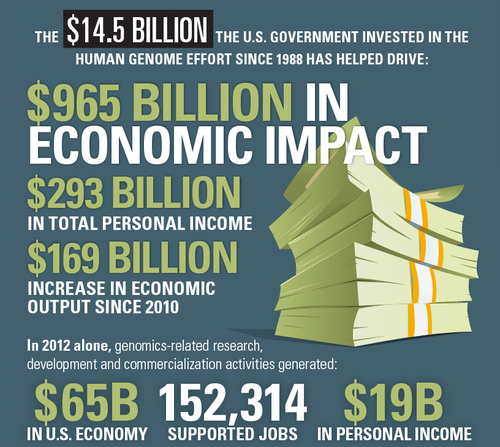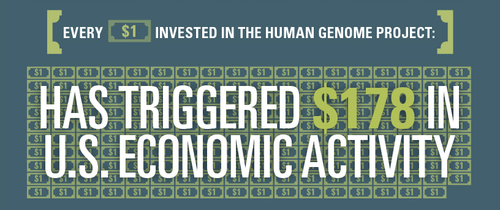
By Shawn Sullivan, FasterCures Program Associate
“An investment in knowledge always pays the best interest.” - Ben Franklin
United for Medical Research and Battelle released a report, “The Impact of Genomics on the U.S. Economy,” that showed every $1 invested in the Human Genome Project has triggered $178 in U.S. economic activity. The report, the focus of a briefing on Capitol Hill along with National Institutes of Health (NIH) Director Francis Collins, also showed that more than 53,000 jobs were directly spurred by the genome project.
“This report illustrates the vital role that key federal research funding plays in growing the U.S. economy, creating new industries and innovative technologies, and producing the diagnostics and treatments that can save lives,” said Carrie Wolinetz, president of United for Medical Research. “As the largest, single undertaking in the history of life sciences, the Human Genome Project has paid back extraordinary dividends on the U.S. government’s investment.”

The report estimates that, in 2012 alone, genome sequencing endeavors and related activities have led to $65 billion in U.S. economic output, $31 billion in U.S. GDP, and $19 billion in personal income. These benefits come at a cost of roughly $2 per year per U.S. resident.
Martin Grueber, the research leader at Battelle and co-author of the report, pointed out that the tax revenues that have been returned to the federal government due to the economic activity generated by advances in genomics have exceeded the governments’ initial investment. This is already true, despite the fact that “the broad and functional impact of the Human Genome Project is just now beginning to be realized.”
The chairman and CEO of Life Technologies, Gregory Lucier, said that it was critical that the federal government stepped in to make the initial investment in the Genome Project because, at the time, “It was unclear if there was going to be a commercial application.” Eric Green, director of the National Human Genome Research Institute at the NIH, reinforced the point that the commercial applications for the knowledge generated by mapping the human genome are almost limitless now and gives the private sector “tremendous credit for seeing the opportunity here.”
Collins, who directed the Human Genome Project from 1993 to 2008, pointed out that the project has “been a remarkable stimulus for the U.S. economy,” but that due to the recent sequester that cut $1.7 billion per year from the NIH budget, the next great project may not take place in the United States. Collins mentioned that while we are cutting our commitments to biomedical research, other countries are increasing theirs. “They have read our playbook,” Collins said, adding, “They have seen how many jobs are created by this enterprise.”
The positive economic effects that come from federal investment in science are a profound argument for increasing these investments, not cutting them back at a time when the promise of science has never been more exciting. But ultimately, the most important reason to make these investments is to deliver new cures and treatments to the patients who need them. While we are seeing increased rates of diseases like cancer that have a strong genetic component, we cannot afford not to make these investments. Disease is much more expensive than cures, and the societal gains that come with saving a life are immeasurable.
Graphics courtesy of United for Medical Research


Likewise, the affirmed worker will have the option to help other people as well, telling them the best way to turn out to be increasingly gainful and efficient.ExcelR PMP Certification
ReplyDeleteGreat Article
ReplyDeleteData Mining Projects IEEE for CSE
Project Centers in Chennai
JavaScript Training in Chennai
JavaScript Training in Chennai
Thank you so much for ding the impressive job here, everyone will surely like your post.ExcelR pmp certification Bangalore
ReplyDelete